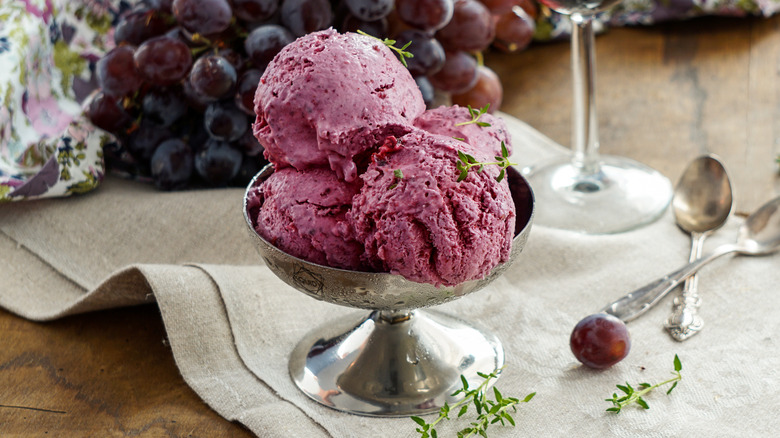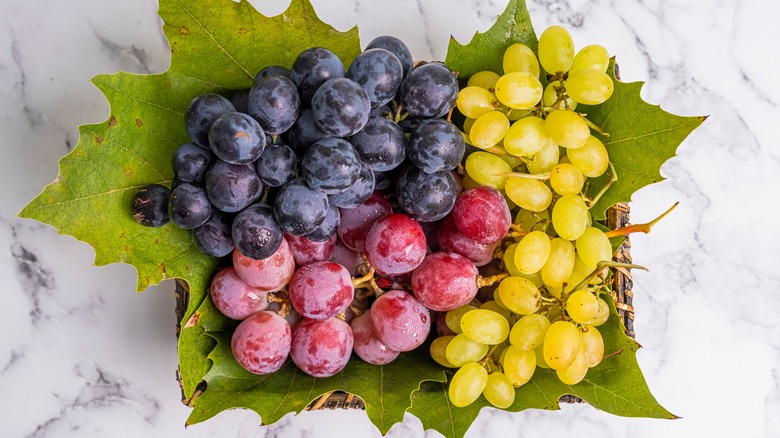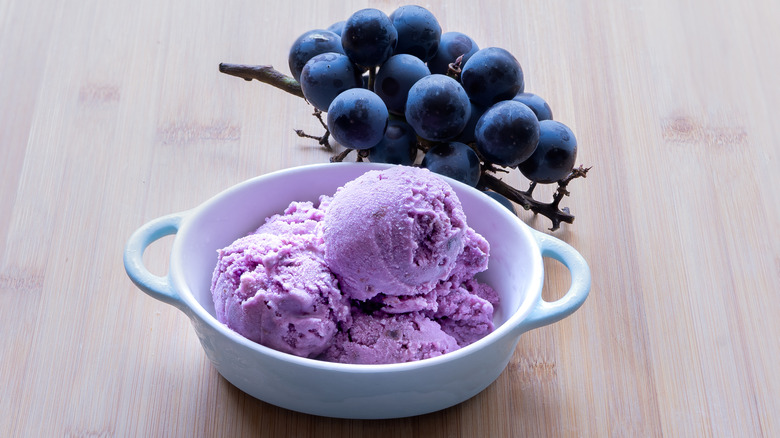Why You Won't See Grape Ice Cream On Store Shelves
When perusing the freezer aisle, you'll see all sorts of different ice cream flavors, from classics like vanilla and chocolate to wild cards like everything bagel and Dijon mustard. However, you might have noticed that across pretty much all brands, grape ice cream is conspicuously absent.
One of the biggest reasons for this is the texture of grapes. Grapes are more than 80% water, meaning they have a high capacity for forming ice crystals when frozen. These ice crystals break the cell walls as they form and expand, essentially causing the grapes' internal structure to collapse, leaving us with slimy grape mush. Not very appetizing.
Sure, the texture problem could be somewhat mitigated by pureeing the grapes, which would break down the cell walls and prevent them from becoming chunky and slimy in the ice cream. That being said, pureeing grapes on a large scale takes a lot of time and effort, and usually results in juice, not a puree. As such, it's simply not worth it for our favorite ice cream brands to go that extra mile.
Grape flavor is finicky to nail down
Given the challenges of using real grapes in ice cream, you might wonder why ice cream brands don't simply use artificial grape flavor. After all, this would eliminate the need to use real grapes. However, as many of us have experienced, artificial grape flavor tastes quite different from the grapes we're familiar with.
This artificial flavor is made with a chemical called methyl anthranilate, which is indeed found in purple Concord grapes. While Concord grapes are certainly a popular types of grape, their taste differs significantly from that of varieties like Thompson and Crimson seedless grapes. The latter, also known as table grapes, are more commonly eaten as snacks, and their complex taste is what we typically associate with true grape flavor. In contrast, Concord grapes are more often used in juices and jams.
All in all, whether ice cream brands opt for artificial grape flavor or juice from fresh Concord grapes, the result would be a frozen dessert that doesn't quite taste like the grapes we're accustomed to eating.
Ice cream and grapes just don't mix in our minds
Yet another reason why brands don't put grape-flavored ice cream on store shelves is the financial risk. Simply put, when most customers think of ice cream flavors, grape doesn't usually come to mind. Cherry, strawberry, banana, yes, but grape? Not so much. And even if some people were interested, brands would have to consider whether the grape ice cream enthusiasts would actually purchase enough to make the investment profitable.
Moreover, the flavor notes of most grapes might make for an odd pairing with ice cream. For instance, Concord grapes are very musky and acidic. In winemaking, these grapes are often diluted and mixed with sugar to tame their taste. Thompson grapes, on the other hand, have a mild taste that's somewhere between sweet and tart. However, tart and acidic flavors border on being sour, which isn't a taste that's in high demand in dairy products like ice cream. We'll stick with strawberries when we crave a fruity ice cream fix, thanks.



